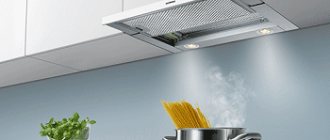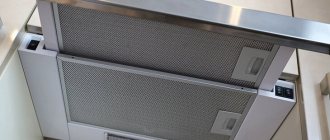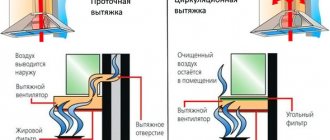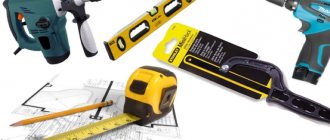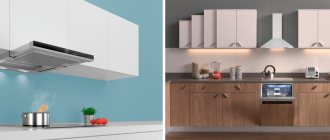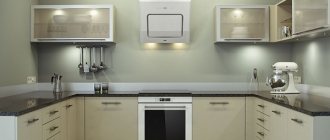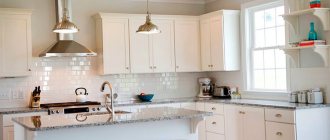Can a hood be silent: innovative developments
When the hood is turned on, it makes noise due to the operation of the motor and fan. Its volume largely depends on the power: the lower it is, the quieter the sound. There are no completely silent hoods. But almost all manufacturers of these devices have models with low noise levels in their assortment.
To achieve this effect and maintain the functionality of the equipment, use the following techniques:
- instead of one fan, two are installed, while the engine reduces speed and sounds quieter;
- they produce devices with thicker walls, which reduce vibrations and absorb sound (disadvantage: increased weight of the product);
- install the fan further from the air intake, the noise becomes quieter, since it does not go into the pipe;
- reduce vibration levels through high quality connections and installation of anti-vibration gaskets;
- the body and parts are made of sound-absorbing materials;
- devices are equipped with smooth running motors;
- install acoustic traps (sound absorbers).
To minimize the noise emitted by a household appliance, manufacturers have developed a noise reduction system.
For example, the Italian company Falmec has created the NRS system, with which the hoods are not only quiet, but also powerful. This technique produces 85% less noise than similar devices. At the same time, the company’s specialists also reduced its energy consumption.
To suppress noise, V-shaped traps are installed, which are made of anti-acoustic material - it absorbs the sounds of the air flow.
Reference. Hoods that use all noise reduction methods create a noise impact of 30 dB at minimum speed.
What noise level does a hood create on average: normal limits
Operating household appliances produce noise, which is measured in decibels (dB). What noise level should a kitchen hood have? This information is usually contained in the technical documentation for the device.
According to the CMEA Standard 4672-84, the noise level should not be more than 72 dB. It depends on the power of the equipment. The noise level standard for average kitchen hoods is 45-55 dB at maximum speed. For more powerful models - from 55 to 65 dB.
For comparison, here are other noise indicators:
- clock ticking - 30 dB;
- whisper of two people at a distance of 5 m - 35 dB;
- normal quiet speech - 40 dB;
- conversation between two people in a normal voice at a distance of 5 m - 50 dB;
- screaming and laughter - 75 dB;
- working chainsaw - 110 dB.
Typically, sounds that produce noise greater than 50 dB are perceived as loud. Sound levels between 110 and 130 dB can cause physical pain in sensitive people.
Reference. Since hoods operate only during cooking and their noise level ranges from 45 to 65 dB, they do not have a strong impact on the human auditory organ.
Causes of noise during operation of the hood
The hood is noisy due to the running motor and fans. The noise level is influenced by the following factors:
- Motor power. The more powerful it is, the greater the fan performance. Air masses move faster, creating a high noise effect.
- Duct size. A channel of small diameter helps to increase the speed of movement of air masses and increase the noise level. Due to bends and transitions, air turbulences are formed, increasing the hum.
- The material from which the air duct is made. A plastic pipe is quieter than a corrugated metal pipe.
- The height of the hood above the hob. If you hang it above the required distance, the operating speed will have to be increased, and the hum will increase.
- Poor installation. Backlash and gaps increase vibration during operation of the device.
- System contamination. Accumulated grease and soot lead to incorrect operation of the device and increased noise, so it should be cleaned periodically.
Features and Benefits
Kitchen hoods are modern household appliances that help solve the problem of indoor air purification. When choosing a hood for the kitchen, many people pay attention, first of all, to the design, size, shape, power, color, material, and also to the most important factor - its noise.
For many, it is also important to have a lighting function, the presence of sensors that respond to humidity, temperature changes, as well as the presence of a panel or device for remote control. The price of this device also plays an important role.
But when choosing a hood for the kitchen, it is necessary to pay special attention to the quality of noise, since such a hood will make being in the kitchen pleasant for any housewife.
This attribute not only allows you to get rid of unnecessary odors, but also provides the opportunity to listen to your favorite music in the kitchen, watch TV, or simply talk to each other or on the phone without raising your voice without unnecessary obstacles. In addition, housewives who have a baby in the house can turn on such a quiet hood without worrying that its sound will wake up the sleeping baby, so you can safely prepare lunch or dinner while the child is sleeping. In addition, a quiet hood is an excellent solution for a kitchen that is combined with a living room. Unnecessary odors will not enter such a living room and family members or guests will not experience inconvenience from the noise of such a hood.
Myth or reality?
Many manufacturers claim that their hoods are absolutely silent, but this is just an advertising ploy, because if you find out reviews from users of this device, it is fashionable to conclude that there are no completely silent hoods. All types of hoods make some kind of sound, noise, the only difference between different hoods is how loud the noise is. Manufacturers try in various ways to minimize the noise level, but they cannot completely get rid of it.
Nowadays, on almost every type of household appliance that makes some kind of noise, an indicator characterizing its level is indicated. But each person is sensitive to this indicator in his own way, so one hood may seem very quiet to some, and quite noisy to others. When there is absolute silence in your kitchen or living room, where the hood is installed, that is, all technical appliances are turned off, then the noise level still exists. This is especially true for city residents; as a rule, the sound background of a standard city apartment is approximately thirty decibels. The critical noise level that causes discomfort to every person is a noise level of about one hundred and twenty decibels.
Nowadays, companies producing kitchen hoods use a lot of tools and technologies to keep the noise level of the hoods lower. The quietest is considered to be a hood whose motor is placed in a special housing that ensures its sound insulation. Some models of kitchen hoods have a panel with which you can adjust the noise level of this device. So, you can set the necessary modality of this device, which suits you in a particular situation, and, accordingly, in this way you can reduce the noise of the hood. When you don't need high power from your kitchen hood, you can lower it and thereby reduce the noise level.
Design features
The performance of the hood affects the level of noise it produces. In general, you should know that there are no absolutely silent hoods for installation in the kitchen.
The word powerful itself initially excludes correspondence with the concept quiet.
The device should “sit” tightly in its designated place. Even the slightest gap increases noise. Traces of cracks should be covered up in order to eliminate the slightest vibration.
Types of silent hoods
Based on the type of operation, silent hoods are divided into exhaust and recirculation hoods. The first ones suck in air and exhaust it through a special channel or ventilation compartment. He does not return to the premises. Such devices are called channel devices. Recirculation units suck in polluted air, clean it and return it back to the kitchen.
Hoods are also divided according to the type of fastening, dimensions and shape. These indicators are taken into account when selecting a device for a specific interior and the size of the room. For small rooms, compact hanging units are purchased.
They fit into any interior and take up little space. They can be placed under the kitchen cabinet. The length of the quietest hood for a small kitchen is only 60 cm, depth and height are up to 40 cm.
An island option is suitable for spacious kitchens. This is a large device and is mounted in the ceiling. Such hoods are often decorated and painted. These models are powerful and quiet (noise level up to 50 dB). Their disadvantage is their high cost.
Advice. The size of the hood should not exceed the dimensions of the kitchen stove, otherwise even the most powerful and silent device will look awkward.
Advantages of quiet models
A quiet hood creates a comfortable environment in the kitchen. It does not interfere with talking or watching TV while cooking. At the same time, it cleanses the air of foreign odors and protects surfaces from grease and soot.
This hood is ideal for a studio apartment, small cottage, kitchen combined with a dining room. The device is easy to operate, it has a wide range of options, several power modes. The design of the models is varied, they can be selected to suit any interior. The main disadvantage is the high cost.
Determining the dimensions of the kitchen hood
The size of the hood is determined according to the following principle - the width of the hood should be equal to the same value as the slab or be greater than it. The most popular designs have the following dimensions - 50, 60 or 90 cm. The range for large slabs is not so diverse; you can choose a model with a width of 100 or 120 cm.
The depth, which can be 30-50 cm, is rarely taken into account, and in vain. This value is not so important, but if you choose the wrong device, the visor will protrude greatly above the stove, which often leads to minor household injuries.
When installing a stone hood, the height of the device is of key importance, which shows the maximum permissible distance between the ventilation hole and the bottom plane of the umbrella. Appliances can have different heights - 150 cm, and some only 100 cm. The maximum permissible distance from the hood to the stove must be at least 60 cm.
Detailed information about choosing a kitchen hood for a gas stove can be found in the video.
What are the noise level standards?
Household appliances are always accompanied by a sheet with the technical characteristics of the device, which indicates the noise level of the hood. However, each person has their own perception. The same sound level can be very loud for one person, but within normal limits for another. The following noises occur in our lives:
- When the music and household appliances are turned off, noise is still present in the room. Absolute silence is very difficult to achieve, especially for residents of large settlements. When a person enters a space far from civilization, the first thing that is immediately noticed is an unusual silence. This is all due to the fact that in such an area the background noise is significantly reduced than in the city. Thus, in a room with the devices turned off, the background sound is 30 dB.
- When two people talk in a loud whisper, the sound level at a distance of five meters will be 35 dB.
- Conversing in a normal voice within a radius of 10 meters or playing music softly creates a noise level of 45 dB. Moreover, this indicator is typical for most modern exhaust systems.
- A conversation between two people in a normal voice (not deliberately lowered) at a distance of 5 meters is 50 dB. For many people, such a sound does not cause discomfort and is considered normal for perception. The brain often considers this to be background noise. However, for people with acute hearing or for those who have nervous overload, it is recommended to choose hoods with a lower noise level, since 50 dB can lead to irritation.
- Sounds that create noise above 50 dB are perceived by the human ear as quite loud. If two people speak in a raised voice at a distance of 5 meters, then this equates to 55 - 60 dB.
- Noise levels between 110 and 130 dB, depending on individual perception and the state of the nervous system, can lead to physical pain.
Since the pain threshold for a healthy person with normal hearing is from 110 to 130 dB, and kitchen exhaust systems create a sound of only 55 to 65 dB, there is no strong impact on the auditory organ of people in the room. In addition, it only works during cooking.
Reducing hood noise
Cheap appliances are usually louder due to poor assembly.
There are two ways to reduce the noise of the hood. The first is to carefully calculate the characteristics of the device in accordance with the volume of the kitchen, the distance to the ventilation shaft, and the installation height. The second is to follow the rules during installation and check the fastening of all elements.
Inexpensive devices that are made of low-quality materials and assembled with errors are usually noisy. If the hood costs above average, its build quality is better and it makes less noise with the same power.
The performance of the device is selected taking into account the area of the kitchen, but at the same time with a small margin so as not to turn on the hood at full power. Then the noise level will be acceptable. Formula for calculating optimal performance: Skuh×Hpot×12×1.3; where Skuh is the kitchen area, Hpot is the ceiling height.
The diameter of the duct must correspond to the exhaust power. Recommendations are presented in the table:
| Exhaust power, m3/h | Section, mm |
| 150-200 | 100 |
| 200-1000 | 150 |
| >1000 | >200 |
Muffler for the hood, lined with mineral wool
. To make the kitchen hood quieter, the cabinet in which it is built is covered with sound-absorbing materials and the air duct is soundproofed. There are special noise absorbers for ventilation ducts, which look like separate fragments. They are made of sound-insulating materials and are installed in the channel gap. As a result, sound waves are muffled, while at the same time there is no unnecessary load on the air duct and no obstacle to air flow is created.
They try to make as few turns and transitions as possible or not make them at all. A right angle, if it cannot be avoided, is rounded or divided into 2 angles at 45 degrees.
When installing the air duct, ties, clamps, and sealant are used. The hood is secured tightly so that there is no play. Even a small gap between the wall and the device causes vibration and noise. If extraneous sounds occur, the fastenings must be checked and tightened.
Observe the working height of the installation: for an electric stove - 60 cm, for a gas stove - 75–80 cm. If the distance is greater than the recommended one, the hood power must be increased, otherwise it will not perform its function properly. If you install it lower, the plastic parts will melt and they will also make noise.
What technologies help reduce noise levels?
Silent modern kitchen hoods surprise cooking lovers with their excellent design, good power and performance. With the help of such a household appliance, it becomes possible to create culinary masterpieces while watching your favorite TV series, listening to music programs or talking on the phone. If there are small children in the apartment, quiet hoods during work will not disturb their sensitive sleep. Due to this, they can be installed even in kitchen areas combined with another room.
To ensure low noise levels during operation of the exhaust system, manufacturers have applied the following measures:
- They increased the number of fans - from one to two. Thanks to this, the engine reduced speed and began to sound quieter. In addition, dual-fan hoods have a significant power reserve.
- The thickness of the body walls has been expanded. With very thin case walls, the sound level will be louder. In addition to the fact that practically nothing will interfere with it, the walls themselves will resonate. With thick walls the sound will be much quieter. However, this method led to an increase in the weight of the household appliance, so increasing the thickness is possible only within reason.
- The fan was located further from the air intake.
- Acoustic “traps” (sound absorbers) were installed in the inside of the housing.
What noise can an exhaust system make?
During their operation, all hoods create extraneous sounds. If there is a rattling or vibration effect, then this indicates the presence of play in some place, a loosely fixed housing, air duct, or a problem in another mechanism.
If the exhaust system blades are dirty, you will hear the fan hum. Due to the narrow cross-section of the air duct, air flows at a higher speed and creates a hum. Since the motor is running when the hood is turned on, this process is also accompanied by a characteristic hum.
Knowing all the sounds, you can understand by ear whether they are related to a breakdown or not. Repair will be required in the following cases:
- When the sound suddenly changes during operation (extraneous sounds appear or noise noticeably increases). If the exhaust system has been installed for a long time and is regularly used in different modes, the change in sounds will become noticeable immediately.
- When extraneous noise, vibration and rattling appeared in the case. This may be due to play in the moving part.
- When the hood operates in normal mode without changing the sounds, but the air is not removed.
Performance calculation
There are several main parameters of the exhaust system.
- Performance shows how many cubic meters of air the hood passes through the entire structure during an hour of operation.
- The volume of the room where the kitchen is located - the larger it is, the higher the productivity should be.
- The power of the hood depends on the size of the room.
As we see, all these parameters are related to each other, they can be calculated using a simple formula - we multiply the height and area of the room by 12. This is how many times per hour, according to all Russian standards, the air must be completely renewed during cooking.
If you plan to remove polluted air from the room, then the result must be multiplied by a factor of 1.3 - it takes into account the length of the standard air duct, the depth of the shaft, and the number of floors of the building.
For example, you live in a standard five-story house: the kitchen area is only 6 square meters. m., ceiling height is 2.25 m and you choose the outlet option. Then we get 6 x 2.25 x 12 x 1.3 = 210.6 m3/h - you need a hood with a capacity of at least 250 cubic meters. m in. If you install a recirculation system, the result will be 162 m3/h.
Many users will ask - why are these calculations needed? They are made in order to select an acceptable exhaust system specifically for your kitchen. When purchasing a hood, focus on the required performance and the noise level produced.
You need to know that when choosing a new exhaust system, its performance is taken with some margin in order to ensure normal circulation.
Why are hoods noisy?
Kitchen built-in hoods have two elements in the design that can produce extraneous sound, increased noise levels or even vibration: an electric motor and a fan. The device is 50 cm or 60 cm, built-in or wall-mounted, the presence of extraneous sound does not depend on this. The body and design elements of the ixbt are involved in this process as secondary, but often they also require attention.
The extent to which the noise of a working kitchen hood is increased depends on the power of the engine, on the parameters of its mounting in the housing, on the presence and quality of vibration dampers. Proper installation of the equipment is also important. A silent hood for the kitchen is the choice of equipment with optimal performance indicators and the elimination of all possible factors affecting noise generation. You can choose a hood if you know some parameters:
- The power of the fan electric motor, which provides performance and creates the necessary volume and speed of movement of air masses through the air ducts.
- The length and cross-section of air ducts can have a significant impact on noise levels.
- Condition of the internal surface of the air duct. Smooth or corrugated, metal or plastic.
- Transitions of the air duct from one section to another, the presence of bends at which the hood makes noise.
- Choosing the installation location for the hood, its proximity to heating systems and gas pipelines, touching furniture and interior items.
- Incorrectly installed built-in kitchen hood, distortions and lack of vibration dampers.
- Presence of contaminants on fan parts, untimely cleaning of filters and exhaust system,
- Lack of clear documentation on safe operation for built-in kitchen hoods 60 cm.
Selection rules
In order to choose a hood that produces minimal noise levels, you need to follow several important tips. You should not buy a hood that is too powerful, especially if the size of your kitchen does not require it; although it will be effective, it will be too noisy for a small room. The most optimal noise level for the human ear is about forty decibels, so try to buy a hood whose noise level does not exceed this figure. Try to purchase a kitchen hood that will have a remote control or control panel, with which you can select its appropriate operating mode, adjust the power, and, consequently, the noise level of this home appliance.
Another factor that can affect the sound volume of the hood is the level of dirt. Uncleaned filter elements of this device are many times louder than cleaned ones. It is also necessary to clean the air vents, since their contamination can also cause an increase in the noise of the kitchen hood. That is why, when purchasing this device, you need to buy special cleaning products and devices along with it. When choosing a kitchen hood, remember that there are no completely silent hoods; each such device makes sounds, so give preference to the device with the most comfortable noise level for you individually.
Review of powerful and quiet kitchen hoods
Modern buyers, in the process of choosing and purchasing an exhaust system for the kitchen, first of all pay attention to devices with low noise, high power and an acceptable price tag.
Below is a rating of the best hoods for purifying the air while cooking.
Bosch DFS 067K50
This hood is a premium model; it can be built into a hanging cabinet, the width of which is 60 cm. It has a retractable screen and a decorative metal panel. The aluminum grease filters are dishwasher safe. The main parameters include:
- Touch control capability.
- Design of two motors, which has additional sound insulation.
- The brushless motor allows the hood to operate economically and quietly.
- Low noise. In normal mode, the noise level ranges from 40 to 54 dB, and in intensive mode - from 61 to 66.
In addition, the hood has a sensor that analyzes how much evaporation has arrived and activates the appropriate mode. If it works in intensive mode for more than 6 minutes, then after this time it will automatically change to a lower one. The price for this model varies from 35,000 to 38,000 rubles.
Elica Shire BL/A/90
The Elica brand exhaust system has an inclined design, making it suitable for any interior. The maximum output in mode 3 reaches 1200 cubic meters per hour. It can be built into a 90 cm closet. Not only the recirculation function predominates, but also the diversion function. The diameter of the air outlet is 15 cm. The noise level during operation of the device does not exceed 68 dB. Its biggest advantage is electronic touch control. The average price is 17,900 rubles.
ELIKOR Lapis lazuli 60
This model has a modern design and wide functionality. It qualitatively removes polluted air from the room and additionally illuminates the kitchen area. The exhaust system is equipped not only with a ventilation mode, but also with recirculation. Productivity can reach 430 cubic meters per hour in the third mode. The minimum noise level is 34 dB, and the maximum is 54 dB. It also has a grease filter and a place to install an active one. During operation it consumes 225 W. The average price tag for it varies from 10,100 to 10,600 rubles.
Krona steel Bella 600
Hoods from this company are produced in Germany in various colors. Krona steel Bella 600 has an elegant design and is of high quality. It has a grease filter and a separate niche for coal, but you need to buy it yourself. The hood has three speeds, which must be switched manually. Maximum productivity is 390 cubic meters per hour. At the same time, it is powerful and consumes 110 W during operation. The noise level can vary from 39 to 46 dB. The price starts from 8500 rub.
Cata TF 2003 Duralum
This is a Chinese hood with two speed modes that can only be switched with buttons. This model also has backlighting in the form of two lamps, heating up to 40 W each. There is no circulation or filtration mode. The diameter of the fitting is 120 mm. The maximum productivity it can produce reaches 600 cubic meters per hour. The average price for this model starts from 7,200 rubles.
Elica Oretta Wh/A/60
The undisputed leader from Italian manufacturers, judge for yourself: the performance in the mode of removing contaminated air outside the room is 900 m3/h, during circulation up to 650 m3/h, the maximum noise level is no more than 32 dB. Very elegant appearance, lighting - two halogen lamps of 28 W each, control of speed modes is standard, mechanical.
There is a circulation mode, while the air is purified from impurities using a high-quality carbon filter. The price range is from 22.99 to 35 thousand rubles - you have to pay for excellent quality.
So far, absolutely silent similar household units have not been invented, but the consumer can choose an acceptable option for himself, based on the cubic capacity of the room and its interior. Some will be happy with an inexpensive but good quality range hood, others are looking for an exclusive option for a combined kitchen and living room in a country cottage for any money.
CATA LF-2060 - with a maximum noise level of 51 dB.
The case is made of black metal, small in size 8.5x60x45cm. The glass panel looks good in the kitchen and, when lifted, prevents the spread of grease particles inside the room.
The productivity is 320 m³/h in free air outlet mode. The maximum sound impact level in first speed mode is no more than 35 dB.
Advantages:
- German build quality
- Stylish, ergonomic design
- Bright backlight
- Convenient control
- Energy Saving
- The quietest kitchen hood
Flaws:
- Low-power for large kitchens, as the design includes 1 motor
The front glass panel leaves no marks and is fairly easy to clean.
High-quality German assembly guarantees uninterrupted operation of this device for 5 years from the date of purchase.
On average, the proposed model will cost the buyer from 3,990 to 4,271 rubles. Excellent value for money and quality.
Krona Kamilla power 600 inox
This dual-motor model is capable of effectively removing unpleasant odors and also features a sliding design. Due to the retractable design, its considerable dimensions (60x60x31cm) are hidden.
In one hour of operation at a power of 210 W, it is capable of cleaning and processing about 800 cubic meters. m/h.
Advantages:
- Low noise at speeds 1 and 2
- Pull-out section
- Sleep timer - 15 minutes
- Powerful
- With two motors
Flaws:
- Inconvenient control buttons
- Stainless front panel
The silver decor on the pull-out carriage matches the rest of the kitchen appliances harmoniously.
The main thing is the low noise level, which allows you to feel comfortable when working in the kitchen. The manufacturer guarantees high-quality, long-term service for 7 years.
The price tag starts from 5,300 to 8,199 rubles. This relatively high price is due to the quality of the German assembly.
MAUNFELD Crosby Single 60 stainless steel
The TOP continues with the very quiet built-in hood MAUNFELD Crosby Singl 60. This option differs from the device produced by LEX in that there are no retractable parts. As a result, the hood becomes completely invisible after installation. All control buttons here are located at the bottom. The switches are mechanical, recessed.
Crosby Singl is noticeably quieter than competitors at the first two speeds. If you choose the third, whose productivity reaches 850 cubic meters per hour, then the noise will reach 48 dB, which is slightly higher than a comfortable level.
The service life declared by the manufacturer with regular use of the hood is 10 years. The official warranty for the device is 3 years, which is longer than most competitors offer. The lighting system in Crosby Singl is equipped with 2 halogen lamps with a total power of 40 W.
Advantages:
- compact dimensions;
- moderate cost;
- discreet installation;
- high level of productivity;
- good filtration.
Flaws:
- noise at 3rd speed;
- power consumption 190 W.
CATA C 500 glass inox
Let's move on to fireplace hoods, and the first on this list is CATA C 500 glass. The prefix inox in the name indicates the color, which in this case is silver. There is also a black version of this hood. The characteristics of both modifications are similar. The device contains a motor with a power consumption of 95 watts. The performance of this engine can reach 650 cubic meters per hour. Such indicators are relevant for the third speed, and even in this case the device remains almost inaudible - only 37 dB. This makes the CATA C 500 glass the quietest range hood model presented in our review, and one of the best on the market overall.
Advantages:
- decent performance;
- low noise level;
- attractive design;
- two 40 W halogen lamps
Exiteq EX-5026 60 BK/IX
A productivity of 600 cubic meters per hour of operation, three speeds, mechanical control and a two-year warranty - this is what Exiteq offers to buyers of its virtually silent EX-5026 60 hood. Even at the power limit, the device does not produce sounds louder than 39 decibels. At the same time, as a rule, in most cases, buyers choose the second mode, which makes the hood even quieter.
The motor installed in the device consumes up to 185 W of energy, which is not very economical. However, taking into account the high efficiency, excellent design, high-quality assembly and a very attractive price of 9,500 rubles, this shortcoming becomes insignificant. The lighting in the EX-5026 is provided by a pair of halogen lamps, each with a power of 35 W. The device is painted black and gray, but also has other colors.
Advantages:
- convenient control;
- high efficiency;
- convenient control;
- colorful appearance;
- noise at third speed;
- price-quality ratio.
Flaws:
- energy consumption is high.
DACH SANTA 60 BLACK
A reliable, quiet and economical option for an apartment or house. DACH SANTA 60 can effectively operate on an area of about 15 square meters (600 “cubes” of air/hour). The device is equipped with a 65W motor, consuming only 68 W at maximum 3 speed. To illuminate the work area, an excellent 60-centimeter-wide hood uses two LED lamps with a total power of 3 Watts. They are durable and very bright, while consuming a minimum of electricity.
The hood is controlled using touch buttons located at the bottom of the front panel. It’s not very convenient that before selecting one of the 3 speeds, the device must first be turned on with a separate button. On the other hand, this prevents accidental clicks. Another touch key is responsible for turning the backlight on and off. Like other models, SANTA 60 can operate in drain and circulation mode. But in the second case, you will need to purchase an additional carbon filter.
Advantages:
- anti-return valve;
- low power consumption;
- quality materials;
- thoughtful management;
- bright lighting.
Flaws:
- the body gets dirty easily.
CATA C 900 black halogen
We didn’t have to think long about who to put in first place. A high-quality range hood produced by the Spanish brand CATA is an excellent solution for large kitchens. Capacity of 1100 cubic meters. m/h is enough for effective air filtration in rooms measuring 25-30 square meters. Moreover, we even indicated the area with a reserve in case of severe burning of food on the stove, which requires very fast air purification.
The CATA C 900 hood has three operating modes. The noise level at maximum power here is 44 dB. But if you have a small or medium-sized kitchen, then you can turn on speed 1-2. This will ensure the desired result without unnecessary noise.
Among the advantages of the reviewed model, we can also note excellent lighting. Of course, for 14 thousand rubles, many would like to see LED lamps in the hood, but two halogen lamps with a power of 50 W each are also quite a good option. The power consumption level for the C 900 is stated at 240 W. This is the highest figure in the review, but if you take into account the efficiency of the device, it turns out to be quite ordinary.
Advantages:
- stylish design;
- body materials;
- performance;
- bright lighting;
- Spanish quality.
Flaws:
- high price;
- noise at high power.
Shindo Remy sensor 60 B/BG
The device, model Shindo Remy Sensor 60 B/BG 3ET, is a model equipped with a touch panel and a smart control system. There is an automatic shutdown that reacts by stopping operation when humidity and air temperature normalize.
Kitchen hood with a sophisticated design, durable metal base and glass surface.
The dimensions of the device are 78.5x60x32.5cm. The inclined position of the air intake ensures efficient operation.
Advantages:
- Auto shutdown
- Removable filter that can be easily washed and not replaced
- Low noise level in all operating modes
- Stylish design
- Responsive sensor
Flaws:
- Insufficient lighting
- Heavy
Ergonomic, stylish design and control system make the device indispensable. The manufacturer provides a full performance guarantee for 7 years. The cost of the device is overpriced among its competitors, from 9,500 to 18,000 rubles.
Top 3 quietest built-in 60 cm wide hoods for the kitchen
The most popular in the kitchen remain compact 60 cm hoods for small spaces and stoves. Therefore, the search for low-noise models is usually carried out in this category.
Kronasteel 2M 600
A low-noise model with an average output of 550 m3 and push-button control, equipped with backlight lamps and two fans. At minimum power it produces a hum of 46 dB and does not interfere with conversations. It is characterized by simple operation and high reliability.
The cost of Kronasteel 2M starts from 4300 rubles
pros
- two motors with low power consumption;
- reliable push-button control.
Minuses
- productivity is average;
- at the last speed the noise increases to 56 dB.
Hansa OSC 6111
An inexpensive range hood is quite quiet, but is only suitable for very small kitchens. Compact dimensions negatively affect power - the device passes only 200 m3 of air per hour. The model is controlled using a slider, there is a dim backlight.
You can buy a low-noise Hansa hood from 2800 rubles
pros
- is cheap;
- the minimum noise is 36 dB.
Minuses
- at maximum power the hum increases to 52 dB;
- productivity is very low.
Bosch DFS 067K50
A small built-in hood with a retractable panel and touch controls is equipped with bright lighting. There are two motors and additional sound insulation is provided. There is a sensor responsible for automatically switching modes.
You can buy a Bosch DFS kitchen hood from 46,000 rubles
pros
- at minimum power the noise is no more than 40 dB;
- productivity 760 m3;
- bright backlight.
Minuses
- at high speed the hum rises to 66 dB;
- touch controls are not very reliable;
- expensive.


